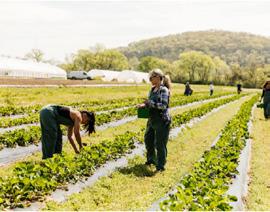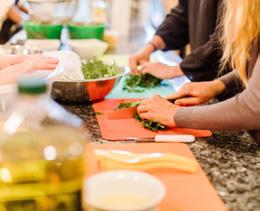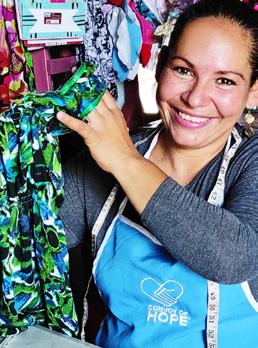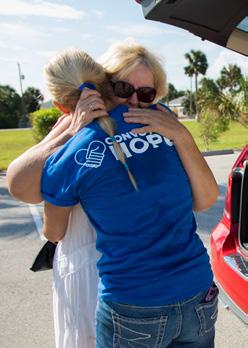Cultivate Reflections





Bread is made up of four simple elements: flour, water, salt, and yeast. When they come together, they create a completely new substance. Bread has been a staple food throughout most of human history.
It’s tempting to believe our cooking and eating are individual activities. We choose the food we want to eat. We enjoy that food, or we feel guilt or shame over that food. We experience the ramifications of eating things that don’t settle well on our stomachs, and we watch our body grow and build strength in response to the nourishment we take in.
But baking, cooking, and eating aren’t done in isolation. The fruits, vegetables, and grains we consume are nurtured with the help of microbes and earthworms that nourish the soil, bees that pollinate, and farmers who manage crops. When food is prepared, the knowledge of how to prepare it has already been passed down for generations. Most often, this work is owned by women. And most often, it involves some form of bread. Recipes tell the stories of families, friends, and communities nourishing one another in times of abundance and times of need. When we cook or eat, we are drawn into fellowship with people — from history and those around the world — who have expressed love by preparing food.
You might have a positive relationship with food, remembering summers spent with your grandmother and learning to layer biscuits and ice cakes. You might also remember watching your father man the stove, filling the entire house with the scent of onions, garlic, and herbs. You could also have a negative relationship with food: remembering your mother’s stress in paying for groceries, worrying about weight gain, or fearing that hidden allergens could send your body into shock. Many of us land somewhere in between — enjoying food and laughing with friends but having a constant awareness of the negative role food can play.
Today, we are holding onto the truth that while food can be a point of pain, it holds goodness in our lives. We will be using a handful of recipes to connect us with women around the world — women who also understand the beauty and brokenness of food and who use their cooking skills to support their families.
As you prepare these recipes in the months to come, may you remember the fellowship with women you experienced here today and our fellowship with those around the world. May you remember our sisters in Guatemala and Ethiopia, who provide for their families by selling the delicious food they make. May you remember our sisters in Ukraine, who know the loss of wheat fields and now question how they will make bread.

May you hold fast to the delight you felt today in the kitchen and at the table. Search for small glimmers of goodness every time you eat.
3 cups all-purpose flour or bread flour
½ cup whole wheat flour
1½ teaspoons kosher salt
¼ teaspoon instant yeast
1½ cups room temperature water
1. In a large bowl, mix together flours, salt, and yeast. Add water and mix by hand until fully incorporated. It will feel pretty soupy at first. This is okay!
2. Cover and let sit for 30 minutes. Then, stretch and fold the dough in the bowl 4 to 20 times.
3. Cover again, and let rest for 8 to 24 hours. It will more than double in size. Place the dough onto a floured surface. Then, fold it in thirds (like an envelope).
4. Rotate 90 degrees and repeat. Let the dought rest for 10 minutes.
5. Shape the dough into a round shape or sandwich loaf. Let it rest 30 minutes to 1 hour, until the dough has relaxed.
6. Preheat the oven to 425 F.
7. Bake for 30 to 45 minutes. The crust will turn brown and sound hollow when tapped.
8. Let rest for 30 minutes before serving.

Himbasha is an Ethiopian bread often used for celebration. On a child’s first birthday, himbasha is placed on their back and broken in half to bring prosperity and strength.¹
2 cups all purpose flour or bread flour
3 tablespoons sugar
1 teaspoon instant yeast
1 teaspoon kosher salt
½ teaspoon ground cardamom
½ cup warm water
2 tablespoons olive oil
¼ cup golden raisins
1 teaspoon sesame seeds
¹ Ramakrishnan, S. (2022, February 22). Himbasha | H’mbasha | Ambasha | Ethiopian flatbread. My Cooking Journey. https://www.mycookingjourney.com/himbasha-hmbasha-ambasha-ethiopian-flatbread/
3 tablespoons milk Instructions
1. In a large bowl or base of a stand mixer, combine flour, sugar, yeast, salt, sesame seeds, and cardamom. Form a well in the center of the bowl, and add water and oil.
2. Knead until smooth for about 10 to 12 minutes. (If kneading by hand, this could take up to 15 minutes.)
3. Add raisins and knead the dough until the raisins are distributed throughout.
4. Cover the dough, and let rise in a warm location until it doubles in size. This should take about 1 to 1½ hours.
5. Press the dough into a greased, 9-inch cake pan. If it springs back on you, then let it rest 3 to 4 minutes before pressing to the edges.
6. Preheat the oven to 350 F.
7. Let the dough rest for another 30 minutes until you can poke it with one finger and the indentation slowly fills in about halfway.
8. Using the blunt end of a dinner knife, create a design on the top of the dough. You can get as creative or intricate as you like!
9. Brush the top with milk, and bake for 30 to 35 minutes until the bread is golden brown.

Quesadilla de arroz is a sweet cheese cake made with rice flour. It is popular in Guatemala and El Salvador.
1½ cups grated Parmesan cheese
½ cup milk
4 eggs
1½ cups brown rice flour
1½ teaspoons baking powder
1. Preheat the oven to 375 F.
2. In a small bowl, mix the cheese and milk until combined.
3. Separate the egg whites and yolks. Place the whites in a large bowl or base of a stand mixer. Whip until soft peaks form, then add the yolks one at a time.
4. Sift together the flour, baking powder, and sugar. Fold into the egg mixture.
5. Fold in the sour cream, butter, and cheese mixture. Mix until smooth, but do not deflate the batter.
1½ cups sugar ½ cup sour cream
1 cup melted butter 2 tablespoons sesame seeds
6. Pour the batter into a greased 9-inch by 13-inch pan. Sprinkle with sesame seeds.
7. Bake for 35 to 40 minutes or until a toothpick inserted into the center comes out clean. Let cool, then slice and enjoy!


Adapted from the evening prayer liturgy in the “Book of Common Prayer” and the Bake and Pray loaf.
Begin by gathering your supplies.
• 3 cups unbleached all-purpose flour or bread flour
½ cup whole wheat flour
¼ teaspoon instant or active dry yeast
1 teaspoon kosher salt
1½ cups water, warm to the touch
1 large mixing bowl
1 bowl scraper, if on-hand
1 light, damp tea towel
1 Bible
As you prepare your workspace, also prepare your heart and mind. Slowly breathe and meditate.
Inhale My soul finds rest …
Exhale … in God alone.
Measure the flour, yeast, and salt into the bowl, and continue meditative breathing. Feel the texture and temperature of each element between your fingers. Give thanks for the community of farmers, millers, and grocers who have brought these ingredients to your kitchen. Form a well in the center of the bowl, and pause to pray.

Come, let us sing for joy to the LORD; let us shout to the rock of our salvation. Let us come before him with thanksgiving, and extol him with music and song.
For the Lord is a great God, the great King above all gods. In his hand are the depths of the earth, and the mountain peaks belong to him. The sea is his, for he made it, and his hands formed dry land.
Come, let us bow down in worship, let us kneel before the LORD our Maker; for he is our God, and we are the people of his pasture, The flock under his care.
(Psalm 95:1-7, NIV)
Pour the water into the center of the well. With your fingers, pull the flour bit by bit into the watery center. Thicken the water slowly, pushing out dry clumps of flour as they form. Contemplate the feeling of these substances as they transform within your hands.
As the water thickens, continue pulling in flour until the two mixtures are worked into one. Now stop. The work is not yet done, but it’s not all yours to do.
Gently clean the dough off your hands, first with your bowl scraper and then with warm water. Cover the mixture with the damp towel and step away to a silent place. Trust that transformation occurs when your hands and your heart are at rest.
While you wait, read Exodus 16. Pay attention to the ways God encourages the people to wait and trust in the Lord for daily bread.
My soul proclaims the greatness of our Lord; my spirit rejoices in God my Savior, for he has looked with favor on his lowly servant.
From this day all generations will call me blessed: the Almighty has done great things for me, and holy is his name.
He has mercy on those who fear him in every generation.
He has shown the strength of his arm; he has scattered the proud in their conceit, He has cast down the mighty from their thrones and has lifted up the lowly.
He has filled the hungry with good things, and the rich he has sent away empty.
He has come to the help of his servant Israel, for he has remembered his promise of mercy.
The promise he made to our fathers, to Abraham and his children forever.
Glory to the Father, and to the Son, and to the Holy Spirit.
As it was in the beginning, it is now and will be forever.
AMEN.
“Heavenly Father, in you we live and move and have our being. We humbly pray to you to guide and govern us by your Holy Spirit. That, in all the cares and occupations of our life, we may not forget you but may remember that we are ever walking in your sight. Through Jesus Christ our Lord, Amen.”
Now, uncover your mixture and grip one side of the dough firmly in your hand. Stretch and fold it while contemplating the change that has occurred: water flooding and softening the grain, opening its untapped strength.
Stretch one side and fold it over the dough. Rotate the bowl 90 degrees and repeat. As you build both elasticity and strength, pray with each breath.
Inhale Oh God (stretch) who comes (fold) …
Exhale … to us (stretch) in bread (fold), ...
Inhale … do not (stretch) let us (fold) …
Exhale … go (stretch and fold).
Repeat this three more times. Cover the dough, and let it rest until the same time tomorrow. Remember, transformation occurs even in our rest.
“Glory to God whose power, working in us, can do infinitely more than we can ask or imagine. Glory to him from generation to generation in the Church and in Christ Jesus for ever and ever. Amen.”
A fter the mixture has rested for a day, gather the dough, a bit of flour, a Dutch oven, and a sheet tray or bread pan. As you prepare your workspace, prepare your heart and mind.
S lowly breathe and meditate on these words.
Inhale May the words of my mouth and the meditation of my heart …
Exhale ... be acceptable in your sight, oh God.
A s you spread flour on your counter and place the dough, continue meditative breathing. Smell the scent of fermentation, tangy and a little sweet. Marvel at the beauty and strength of the mixture — of the bubbles that signal new life and growth.
Now pause to pray.
O gracious light, pure brightness of the ever-living Father in heaven, O Jesus Christ, holy and blessed!
Now as we come to the setting of the sun, and our eyes
behold the vesper light, We sing your praises, O God: Father, Son, and Holy Spirit. You are worthy at all times to be praised by happy voices, O Son of God, O Giver of Life, and to be glorified through all the worlds.
Stretch and fold the dough four more times back to front and side to side. As you do, pray this prayer.
Inhale Worship (stretch) the Lord (fold) …
Exhale … in the beauty (stretch) of his holiness (fold). Inhale Let the whole (stretch) earth tremble (fold) …
Exhale … before (stretch) him (fold).
Once again, your bread needs rest. The journey from dough to bread must be slow. As the dough rests, it relaxes into its newfound strength. If you push it, it’s apt to tear.
While the dough rests, preheat the oven to 450 F. If you have a Dutch oven, preheat it too. If not, a tray will do.
While you wait, read Matthew 4:1-11. Pay attention to Jesus’ choice of words. Remember he is both the Bread of Life and the Word of God.
A song from Simeon, who did not die until he saw Jesus face to face
Lord you now have set your servant free to go in peace as you have promised. For these eyes of mine have seen the Savior, who you have prepared for all the world to see.
A light to enlighten the nations, and the glory of your people, Israel. Glory to the Father, and to the Son, and to the Holy Spirit: as it was in the beginning, is now, and will be forever. Amen.
Return to your bread, which should be well rested now, and turn it upside down.
Stretch and fold it four more times, then fold it in half and tug to seal the seam. This will create a tension across the surface of the dough. Place the seam side on a piece of parchment for one last rest. The dough must relax to prepare for this final push, then it will grow with the last bit of energy it can muster.
Now step away to a quiet place. Inhale and exhale with each line of this prayer.
Inhale O Lord, show us your mercy … Exhale … and grant us your salvation.
Inhale O Lord, save our nation … Exhale … and guide us in the way of justice and truth. Inhale Clothe your ministers with righteousness … Exhale … and make your people joyful.
Inhale O Lord save your people … Exhale … and bless your beloved creation. Inhale Give peace in our time, O Lord … Exhale … for only in you can we live in safety. Inhale Let not the needy be forgotten … Exhale … nor the hope of the poor be taken away.
Inhale Create in us clean hearts, O God … Exhale … and take not your Holy Spirit from us.
Repeat this as many times as needed for you to believe these words as truth. Your bread needs half an hour to rest … it’s okay if you do, too. With a sharp knife or razor blade, cut a deep slit across the top of the dough. The fermentation needs an outlet for this final push of energy.
Place the dough in the oven, and spritz the top with a bit of water. Then, watch as the loaf changes before your eyes. Watch the bread grow and relax (for about 30 minutes), then remove it from the oven. Listen to it sing.
As the coolness meets the heat and the loaf tightens up once more, the dough will start to crackle.
When the loaf is cooled completely, break it open and share it with people you love.
May the God of hope fill us with all joy and peace in believing through the power of the Holy Spirit. Amen.

Chances are, you’re exhausted.
We get it. Over the past two years, we’ve all watched as the waves of COVID-19 illuminated fears and fissures within our churches, families, and neighborhoods. We've been confronted with the deep isolation, racism, sexism, and church abuse that plague our world. A lot of the time, it feels like too much to begin to address on our own.
At the Edible Theology Project, we believe that the rest and connection you’re looking for will take place at the table.
As a nonprofit, educational media project, our goal is to bring people together around the table to talk about “food stories” — both global and personal, theological and practical. The goal is to find healing, rest, and joy in the process.
Maybe you’re an individual who wants healing in your personal relationship with food, your body, and the Body of Christ. Maybe you’re a small group leader looking for a curriculum. Or a pastor desperate for a tool to encourage your weary congregants.
Wherever you might find yourself, we have you covered.
We create resources for churches, families, and individuals that help you and yours connect the meal shared at the Communion table to Tuesday night’s leftovers, including our “Kitchen Meditations” podcast and “Bake With the Bible” study.

Learn more about how you can be a part of our work at edibletheology.com .


• Clemson: Bradley and Kaeleigh Pinion hosted their second Community Event with Convoy Nation. On May 21, the Pinions served the families of Clemson Elementary and people in surrounding neighborhoods. There was also an extensive Kids’ Zone that included Bradley and the Clemson football team passing out NFL footballs.

• University of Tennessee: On May 7, our team worked alongside the athletic department at the University of Tennessee for its first-ever Community Event. We served hundreds of individuals and families in Knoxville, with a focus on health and wellness.
• Modesto: Hundreds of families packed the gym at The Salvation Army Modesto Red Shield Center at a recent Community Event. Guests of Honor received school supplies, backpacks, shoes, socks, haircuts, and groceries for the new school year.
• Nashville: Convoy of Hope provided training, seeds, and other supplies to children and senior citizens in one Chicago community so they could start their own vegetable gardens. Check out the video where Convoy of Hope team members demonstrate proper gardening and agricultural techniques.

• Denver: More than 85 Denver-area women gathered to hear the story of Convoy of Hope’s Women's Empowerment initiative on August 11. Participants enjoyed food, friends, and an opportunity to purchase goods from local artisans. Convoy Nation’s Mallory Brown said, “Each of the vendors who came to the event gave a percentage of their sales to Convoy’s Women’s Empowerment initiative.”
• Kansas City: On September 6, three pro-sports teams came together (KC Current, KC Chiefs, KC Royals) for an evening of service and vision casting. Together, they packed hygiene kits, broke bread, and shared visions with one another on how to serve their city in the upcoming years.

• Run for Relief: One of Convoy of Hope’s partners is running the Berlin Marathon. They hope to raise $26,200 for two containers of relief products to be shipped to Ukraine.
• Peloton Challenge: Join the two-month Peloton Challenge to raise money for Convoy’s initiatives. Although the challenge for September is over, it will resume during the month of November. Contact Mallory Brown at (317) 987-3788 to sign up.

Convoy of Hope wants to see lives changed — free from poverty and hunger — through Children’s Feeding. A nutritious meal opens doors to provide children and their families with education, clean water, job and agricultural training, and a sense of hope.

Food security transforms communities by lifting people out of dependence for their daily sustenance. Through Convoy of Hope’s Agriculture program, vulnerable farmers and families are equipped with skills, tools, and seeds to produce life-sustaining crops. Tens of thousands of meals are harvested each year, some of which are used to support Convoy’s Children’s Feeding program — simultaneously generating income for local farmers .
When women are given the opportunity to generate income, it impacts their families and their country’s economic standing. Convoy partners with women to develop sustainable resources that they can leverage to make more strategic, independent life choices.



Convoy of Hope’s Disaster Services team is consistently among the first to respond to disasters at home and around the world. This team is highly regarded for its scalable response and distribution model, which utilizes several warehouses, a specialized disaster response fleet, and a highly trained team of staff and volunteers to respond to disasters quickly and effectively.


At Community Events, Convoy provides free groceries, health services, haircuts, family portraits, job services, veterans services, a Kids’ Zone, a hot meal, new children’s shoes, and much more to those who may not have the means to acquire these things themselves. These events strengthen communities by meeting the immediate needs of local families and creating opportunities for future collaboration between local entities.
Poverty and hunger have devastated rural communities. Rural Initiatives helps local leadership more effectively discover and implement solutions through resourcing, training, mentoring, and coaching. Convoy believes that increased presence and partnership with local leaders will help strengthen and enrich entire neighborhoods and towns.

Your gift can provide one woman with education, training, and equipment to start her own business. She’ll learn skills that will help her provide for her family now and in the future!
Help Convoy Nation continue to create and invite women into one-of-a-kind storytelling experiences within our Cultivate channel.
When a woman starts her own business through Convoy’s program, she receives a startup gift — not a loan — in the form of equipment or supplies. This gift can fuel woman’s dream of running her own business and also lift up her community .